Everyone (well, almost) loves Harry Potter – but Harry and friends are not the only wizards. There’s also Gandalf, of J.R.R. Tolkien’s The Hobbit and Lord of the Rings; Schmendrick, the inept magician of Peter S. Beagle’s wonderful The Last Unicorn; Ged of Ursula LeGuin’s Wizard of Earthsea; Dallben of Lloyd Alexander’s Chronicles of Prydain; and Merlin of the King Arthur tales. And many more.
See below for wizard stories, magic tricks, the science of magic, and all about master magician Harry Houdini.
Table of Contents
FICTIONAL MAGICIANS
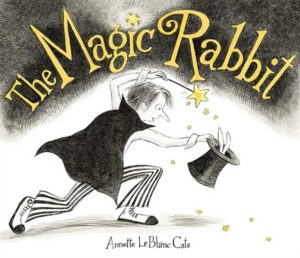
|
Annette LeBlanc Cate’s The Magic Rabbit (Candlewick, 2007) is the picture-book story of the Amazing Ray, a magician, and his best friend, Bunny, who – at the word “Abracadabra!” – leaps from Ray’s top hat in a shower of glittering stars. When the two are separated, after a disastrous collision with a juggler and his dog, popcorn and a trail of golden stars help Bunny find his way home. Simple, but charming, for ages 3-6. |
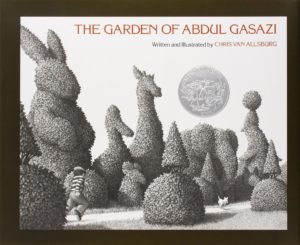
|
In Chris Van Allsburg’s picture book The Garden of Abdul Gasazi (Houghton Mifflin Books for Children, 1979), Alan has been put in charge of Miss Hester’s badly behaved dog, Fritz, who – ignoring the “ABSOLUTELY, POSITIVELY NO DOGS ALLOWED” sign – dashes into the eerie topiary garden of the dog-hating retired magician Abdul Gasazi (and is just possibly turned into a duck). For ages 5-10. |
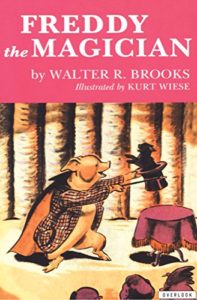
|
In Freddy the Magician (Overlook, 2011), in Walter R. Brooks’s wonderful Freddy the Pig series, the resourceful and hilarious Freddy – with the support of his animal friends at the Bean family farm – sets out to confound the swindling prestidigitator Senor Zingo by embarking on a career in magic. For ages 5-9. The Freddy the Pig website has more information on Freddy and friends. |
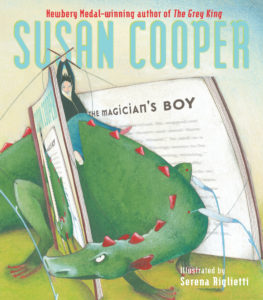
|
The Boy, the hero of Susan Cooper’s The Magician’s Boy (Aladdin, 2006) is the unhappy employee of a magician who refuses to let him learn magic. Instead he polishes the magician’s wand, tends his garden, feeds his rabbits, and operates the puppets for his performances of the puppet play “Saint George and the Dragon.” When the Saint George puppet is lost, the magician sends the Boy to the fairy-tale Land of Story to find it – and after dealing with dangers, difficulties, Red Riding Hood’s wolf, and a dragon, he ultimately wins his heart’s desire. A chapter book for ages 7-11. |
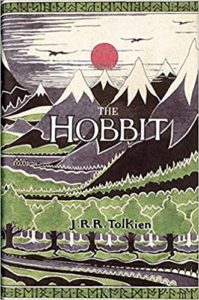 |
In J.R.R. Tolkien’s The Hobbit (HMH, 2012), originally published in 1937, readers are first introduced to Bilbo Baggins, Gandalf the wizard, and Middle-Earth in an adventurous tale that involves dwarves, elves, goblins, and a dragon. For ages 7-12. |
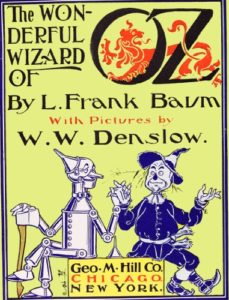
|
L. Frank Baum’s classic The Wonderful Wizard of Oz (available in dozens of editions) was originally published in 1900, featuring – along with Dorothy and companions, an awful Wicked Witch, and some creepy Winged Monkeys – a totally bogus, but endearing, Wizard, who reached Oz by accident (from Omaha) in a hot-air balloon. There are fourteen books by Baum in the original series, though the Oz opus now numbers in the dozens, continued by Ruth Plumly Thompson, John R. Neill, and others. |
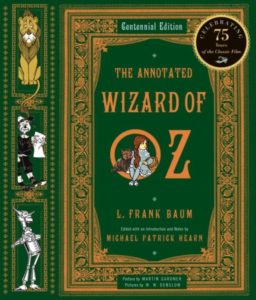 |
For Oz enthusiasts, also see The Annotated Wizard of Oz (W.W. Norton & Company, 2000), edited by Michael Patrick Hearn, which includes a detailed history of the book and its author, hundreds of notes and explanations, and period photographs and illustrations. |
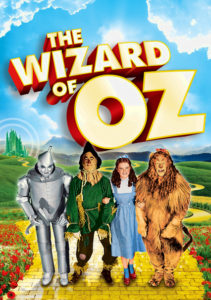 |
In the classic film version of The Wizard of Oz (1939), Judy Garland as Dorothy Gale dances down the Yellow Brick Road with Ray Bolger (the Scarecrow), Bert Lahr (the Cowardly Lion), and Jack Haley (the Tin Woodsman). Margaret Hamilton, in green makeup, plays the Wicked Witch of the West. Rated PG, probably for the creepy Flying Monkeys. |
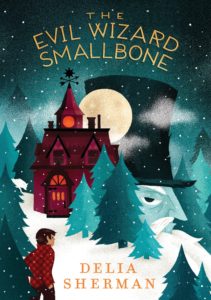 |
In Delia Sherman’s The Evil Wizard Smallbone (Candlewick, 2016), 12-year-old Nick, running away from his abusive uncle, stumbles into the bookstore owned by the possibly evil Wizard Smallbone. A delightful adventure featuring werewolves on motorcycles and a town of enchanted seals. For ages 8-12. |
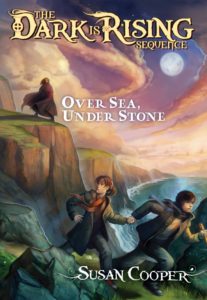
|
Susan Cooper’s Over Sea, Under Stone (Margaret K. McElderry, 2007), the first of the five-book Dark Is Rising series, is the story of Simon, Jane, and Barney Drew who, on a summer vacation at an old house in Cornwall, discover an ancient map. The map leads to a treasure associated with Arthurian legend, a key factor in the ancient battle between good and evil – and the children, with the help of their mysterious mentor Professor Merriman Lyon, must secure it before it’s nabbed by the sinister Mr. Withers and his sister. (By the end of the story, the kids also discover who Professor Lyon really is.) For ages 9-12. Subsequent titles in the series are Greenwitch, The Dark Is Rising, The Grey King, and Silver on the Tree. |
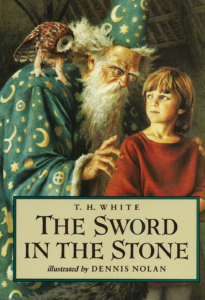
|
T.H. White’s The Sword in the Stone (Philomel, 1993) is the stand-alone first section of White’s longer re-telling of the Arthurian legend, The Once and Future King. Appropriate for ages 9 and up, The Sword in the Stone is far deeper and more complex – and wittier – than the boiled-down Disney movie version. This is story of the boy Arthur – known as the Wart “because it more or less rhymed with Art, which was short for his real name” – and his most unusual education by Merlin, with the help of hawks, owls, fish, ants, wild geese, and Robin Wood (yes, Wood) and his Merry Men. It ends as Wart pulls the sword from the stone and is revealed as King Arthur.
The story continues in The Once and Future King with “The Queen of Air and Darkness,” “The Ill-Made Knight,” and “The Candle in the Wind,” generally recommended for ages 13 and up. |
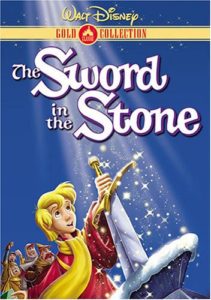 |
The Disney cartoon version of The Sword in the Stone is rated G. |
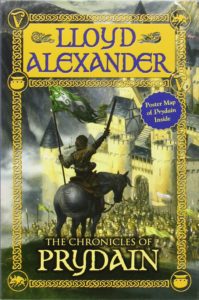
|
Lloyd Alexander’s Chronicles of Prydain (Square Fish, 2011) is a five-book series – The Book of Three, The Black Cauldron, The Castle of Llyr, Taran Wanderer, and The High King – loosely based on Welsh mythology. A wonderful fantasy series for ages 9 and up. As in all good fantasy series, there’s an assistant pig-keeper, a princess, a bard, a dwarf, and a wizard. |
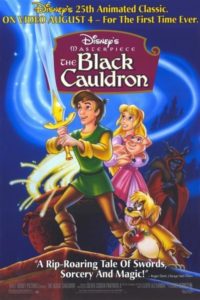 |
The Disney animated movie The Black Cauldron (1985) is loosely based on the first two books of the series. Rated PG. |
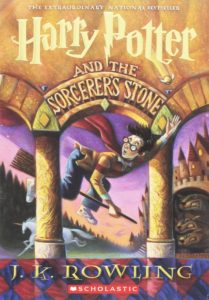 |
J.K. Rowling’s Harry Potter and the Sorceror’s Stone – now available in many languages and editions – is the story of the orphaned Harry, raised by a dreadful aunt and uncle, who finds that he’s actually a magician and has been accepted into the Hogwarts School of Witchcraft and Wizardry. The first of a seven-book series for ages 9 and up. |
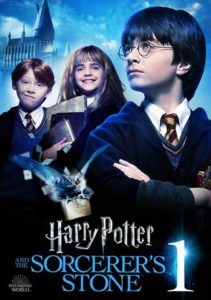 |
Harry Potter and the Sorceror’s Stone (2001) is the first of eight movies based on the seven books. Rated PG. |
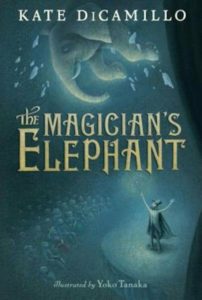
|
In Kate DiCamillo’s The Magician’s Elephant (Candlewick, 2011), ten-year-old orphan Peter Augustus Duchene visits a fortune-teller and learns that his long-lost sister Adele is still alive and that an elephant will lead him to her. That very evening the elephant arrives, crashing through the roof of the town opera house, inadvertently conjured up by a magician. It’s a somewhat dark tale, in which a collection of eccentric characters – among them a beggar, a soldier with a wooden foot, a crippled noblewoman (the elephant fell on her), and a carver of gargoyles – deal with issues of truth, hope, compassion, and ultimately, love. For ages 10-13. |
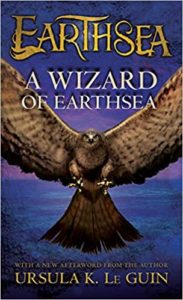 |
In Ursula K, LeGuin’s A Wizard of Earthsea (HMH, 2012), the first of a series, Ged, the greatest wizard in Earthsea, in his youth recklessly loosed a terrible shadow upon the world, and now must hunt it down. For ages 12 and up. |
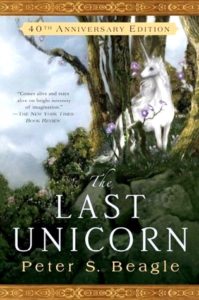 |
Peter S. Beagle’s The Last Unicorn (Ace, 1991) features Schmendrick, an inept magician, who accompanies the unicorn on her quest to find others of her kind – and eventually to confront King Haggard and his Red Bull, who drove the unicorns from the land. For teens and adults. |
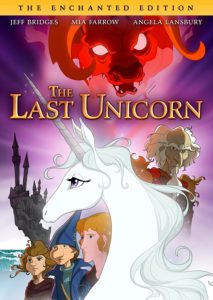 |
The animated version of The Last Unicorn is rated G. |
